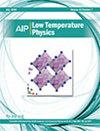Numerical modeling of metal-dielectric metasurface as an element of microwave sensors for biomedical applications
IF 0.8
4区 物理与天体物理
Q4 PHYSICS, APPLIED
引用次数: 0
Abstract
This paper reports the results of numerical modeling of wave reflection coefficient behavior of the metal-dielectric metasurface at microwaves that can be used for biomedical applications. The study includes optimization of the working parameters of the metasurface-based structure as a sensitive element of a microwave sensoring systems for determination of proteins concentration in different solutions. In the current research a unit with the geometry, which is similar to the geometry of one well of the standard 96-multiwell laboratory microplate, is used as a resonant metasurface unit cell and liquid-holding structure. Human serum albumin (HSA) is used as a protein specimen in our model study. The present numerical modeling is based on the results of our previous experimental measurements of complex permittivity values of HSA water solutions and its biochemical reaction mixtures using microwave dielectrometry method and the developed setup. The unit cell approach calculations are performed by COMSOL Multiphysics software. The optimization of working parameters of the metal-dielectric metasurface structure with tested solutions allow us to observe the resonance effects of the wave reflection coefficient in the microwave range. We can determine the HSA concentration changes in water solutions and enzymatic reaction mixtures by the resonance frequency shift of the wave reflection coefficient of the metal-dielectric metasurface. Developed metal-dielectric metasurface-based structure demonstrates prospects to be used as a sensitive element of microwave sensors for proteins concentration determination with biomedical purposes.作为生物医学应用微波传感器元件的金属介电元表面的数值建模
本文报告了可用于生物医学应用的金属电介质元表面在微波下的波反射系数行为的数值建模结果。研究包括优化基于元表面结构的工作参数,将其作为微波传感系统的敏感元件,用于测定不同溶液中的蛋白质浓度。在目前的研究中,一个几何形状与标准 96 多孔实验室微孔板一个孔的几何形状相似的单元被用作谐振元表面单元单元和液体容纳结构。在模型研究中,人血清白蛋白(HSA)被用作蛋白质试样。本数值建模基于我们之前使用微波介电测量法和所开发的装置对 HSA 水溶液及其生化反应混合物的复介电常数值的实验测量结果。单元单元法计算由 COMSOL Multiphysics 软件完成。利用测试溶液对金属介电元表面结构的工作参数进行优化后,我们可以观察到微波范围内波反射系数的共振效应。我们可以通过金属介电元表面波反射系数的共振频率偏移来确定水溶液和酶反应混合物中 HSA 浓度的变化。所开发的基于金属-介电元表面的结构表明,它有望用作微波传感器的敏感元件,用于生物医学目的的蛋白质浓度测定。
本文章由计算机程序翻译,如有差异,请以英文原文为准。
求助全文
约1分钟内获得全文
求助全文
来源期刊

Low Temperature Physics
物理-物理:应用
CiteScore
1.20
自引率
25.00%
发文量
138
审稿时长
3 months
期刊介绍:
Guided by an international editorial board, Low Temperature Physics (LTP) communicates the results of important experimental and theoretical studies conducted at low temperatures. LTP offers key work in such areas as superconductivity, magnetism, lattice dynamics, quantum liquids and crystals, cryocrystals, low-dimensional and disordered systems, electronic properties of normal metals and alloys, and critical phenomena. The journal publishes original articles on new experimental and theoretical results as well as review articles, brief communications, memoirs, and biographies.
Low Temperature Physics, a translation of the copyrighted Journal FIZIKA NIZKIKH TEMPERATUR, is a monthly journal containing English reports of current research in the field of the low temperature physics. The translation began with the 1975 issues. One volume is published annually beginning with the January issues.
 求助内容:
求助内容: 应助结果提醒方式:
应助结果提醒方式:


